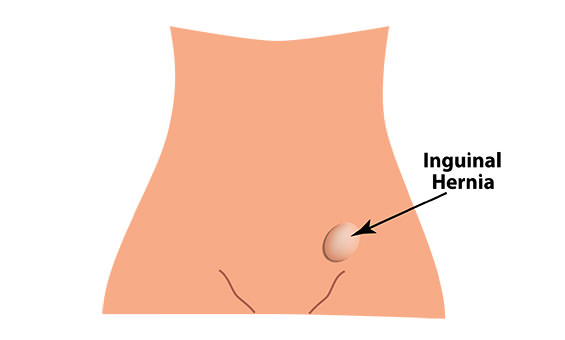Hernias & Gallstones
GROIN HERNIAS
Groin hernias are common surgical problems that occur when there is bulging of an organ or tissue through an abnormal opening in the groin. These include inguinal hernias as well as femoral hernias.
Causes
Groin hernias are more common in men as there is a natural weakness in the muscle layers in the groin that allow the testicles to pass from the abdomen into the scrotum during a males development.

Symptoms
Patients usually complain of a lump in the groin that may cause pain and discomfort. Sometimes, bowel can protrude into the hernia and if the bowel becomes trapped, it can perforate. This is a surgical emergency and you should present to your nearest emergency department.
Tests
Groin hernias are usually diagnosed on clinical examination and routine tests are not required. Occasionally an ultrasound scan or a CT scan is ordered if there is doubt about the diagnosis.
Diagnosis
Total Upper GI surgery will assess and diagnose your groin hernia and discuss the options for treatment with you including surgery and tailor the approach suitable for you.
INCISIONAL HERNIAS
Incisional hernias occur when there is bulging of an organ or tissue through a previous surgical scar/incision. These can occur anywhere on the abdomen.
Causes
Whenever you undergo surgery, there is a weakness in the muscle layers where the incision is made. When these incisions do not heal properly for one reason or another, they can allow the protrusion of a hernia through the old scar/incision leading to the incisional hernia. Certain conditions can affect wound healing including diabetes mellitus, smoking, obesity as well as some medical conditions. It is important that you inform Total Upper GI Surgery of these conditions so they can be optimised before considering surgery.

Symptoms
Patients usually complain of a lump or pain over a previous scar. Sometimes, bowel can protrude into the hernia and if the bowel becomes trapped, it can perforate. This is a surgical emergency and you should present to your nearest emergency department.
Tests
Incisional hernias are usually diagnosed by taking a detailed history and performing a clinical examination. When an incisional hernia is large, a CT scan is performed to help with planning surgery.
Diagnosis
Total Upper GI surgery will assess and diagnose your incisional hernia and discuss the options for treatment with you including surgery and ensure that any medical conditions that may affect wound healing are optimised before surgery is undertaken. Surgery will be tailored to the approach most suitable for you.
ABDOMINAL WALL HERNIAS
An umbilical hernia is a very common condition that occurs when there is bulging of an organ or tissue through an abnormal opening in the umbilicus or belly button.
Causes
The umbilicus is a natural weakness in the muscles of the abdomen that has functions during a babies’ development inside a womb. As such, umbilical hernias can be present from birth or can develop over time when there is increased abdominal pressure.

Symptoms
Umbilical hernias can cause no problems or they can be painful and annoying for patients. They can grow over time and can sometimes include bowel inside the hernia. If the bowel becomes trapped, it can perforate. This is a surgical emergency and you should present to your nearest emergency department.
Tests
Umbilical hernias are usually diagnosed on clinical examination and routine tests are not required. Occasionally an ultrasound scan or a CT scan is ordered if there is doubt about the diagnosis.
Diagnosis
Total Upper GI Surgery will assess and diagnose your umbilical hernia and discuss the options for treatment with you including surgery and tailor the approach suitable for you.
GALLSTONES
Gallstones are a common finding that can cause an array of surgical problems. They form within the gall bladder, an organ that stores the bile produced by the liver, which aids in digestion. Gallstones can irritate the gall bladder leading to “attacks” of abdominal pain after eating, particularly fatty meals. Gallstones can also migrate into the bile duct, which connects the liver, gall bladder and duodenum (small intestine) leading to bile duct infections and even pancreatitis.
Symptoms
- Upper abdominal pain
- Back pain
- Nausea/vomiting
- Bloating
- Burping
- Intolerance of fatty food
- Reflux/heartburn
- Jaundice
- Infection/fever
Medical conditions related to gallstones
- Biliary colic
- Acute cholecystitis
- Obstructive jaundice
- Ascending cholangitis
- Pancreatitis
- Gall bladder polyps

Tests
An ultrasound scan is usually ordered by your GP when gallstones are suspected. This simple test will usually detect gallstones and may show signs of infection in the gall bladder, or stones within the bile duct.
If you present to the emergency department due to severe abdominal pain, you may have a CT scan arranged that may diagnosis gallstones.
Blood tests can show if you have an obstruction where you will have abnormal liver tests. If this is the case, you may need further testing with an MRI scan to identify stones in the bile duct, which may not be detectable on ultrasound or CT scans.
Diagnosis
If you have been diagnosed with gallstones, Total Upper GI Surgery will discuss with you the impact of the gallstones on your quality of life and help you to decide if surgery is the best option for you.


